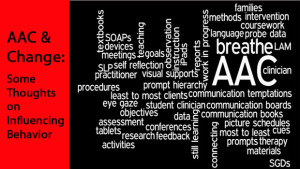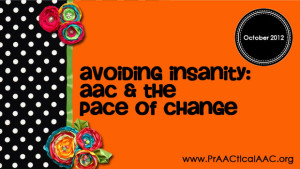October 13, 2012
by Carole Zangari -

As SLPs who do the work of AAC, we all play many roles. We’re therapists and educators. We counsel and coach. We make materials, troubleshoot technology, take data, and write documentation. We advocate for the individual, institution, and society. A common thread that runs through many of these roles is this: Very often, we want people to change their behavior. We may want them to implement a strategy, use different materials, provide more services, agree to a decision, fund a communication device, learn more about what they’re doing, or something else. But we are trying to influence others to change. It is taking us (Robin and Carole) a lifetime to figure out how best to do this. Like you, we face it practically everyday. Each week, we cross paths with a few people who have bad information about AAC, or not enough information, negative attitudes, indifference, or apathy. We try... [Read More...]
Filed under: PrAACtical Thinking
Tagged With: change, implementation ideas, influence, teams
October 4, 2012
by Carole Zangari -

Although the field of AAC emerged only in the last few decades, the notion of communicating in alternative ways is centuries old. In classical times, the use of manual communication by deaf individuals was referred to by Plato and documented in Europe during the Middle Ages. In North America, American Indian Hand Talk evolved over generations to allow cross-cultural communication between speakers of diverse languages. As a clinical/educational field, AAC has been described as evolving through a “bottom-up” mechanism. Individuals with congenital conditions that prevented the development of intelligible speech invented their own communication systems long before teachers, therapists, and clinicians formalized instruction in alternative modes of expression. AAC users growing up in the forties and fifties tell of communicating through grunts, vocalizations, “air writing,” and eye movements, which, though effective in some contexts, were maddening in their limitations. Individuals who were fortunate enough to have access to habilitative and... [Read More...]
Filed under: PrAACtical Thinking
Tagged With: advocacy, change, historical perspective, ideas

